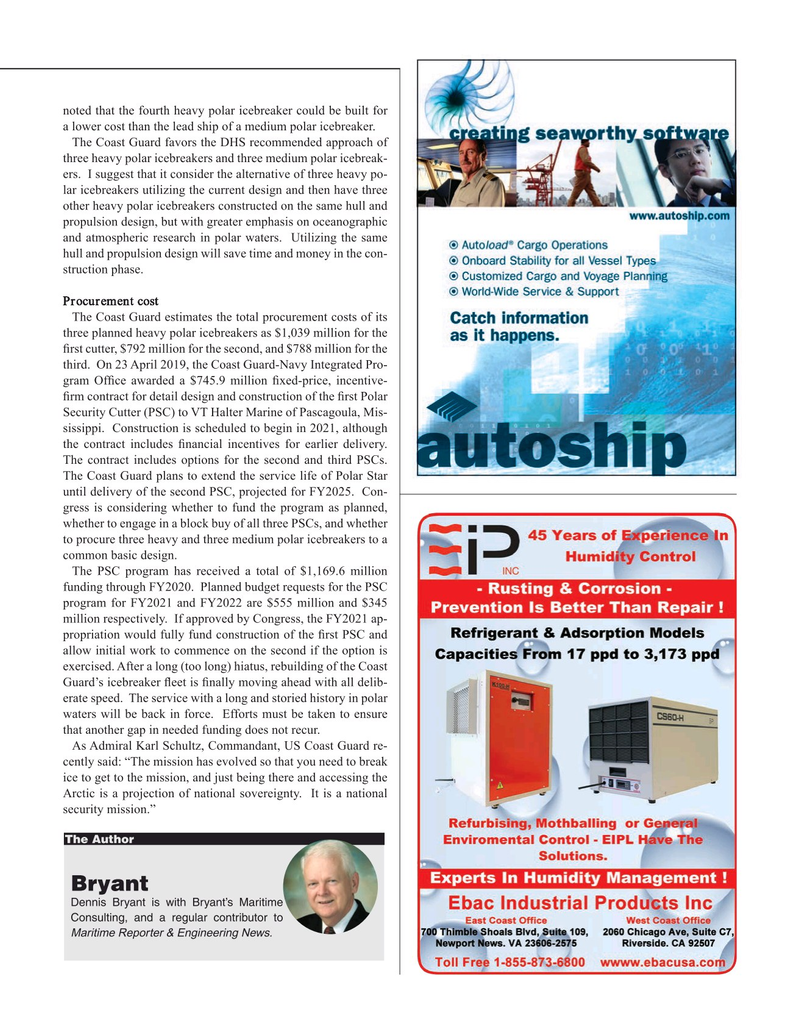
Page 23: of Maritime Reporter Magazine (April 2020)
Offshore Energy Edition
Read this page in Pdf, Flash or Html5 edition of April 2020 Maritime Reporter Magazine
noted that the fourth heavy polar icebreaker could be built for a lower cost than the lead ship of a medium polar icebreaker.
The Coast Guard favors the DHS recommended approach of three heavy polar icebreakers and three medium polar icebreak- ers. I suggest that it consider the alternative of three heavy po- lar icebreakers utilizing the current design and then have three other heavy polar icebreakers constructed on the same hull and propulsion design, but with greater emphasis on oceanographic and atmospheric research in polar waters. Utilizing the same hull and propulsion design will save time and money in the con- struction phase.
Procurement cost
The Coast Guard estimates the total procurement costs of its three planned heavy polar icebreakers as $1,039 million for the frst cutter, $792 million for the second, and $788 million for the third. On 23 April 2019, the Coast Guard-Navy Integrated Pro- gram Offce awarded a $745.9 million fxed-price, incentive- frm contract for detail design and construction of the frst Polar
Security Cutter (PSC) to VT Halter Marine of Pascagoula, Mis- sissippi. Construction is scheduled to begin in 2021, although the contract includes fnancial incentives for earlier delivery.
The contract includes options for the second and third PSCs.
The Coast Guard plans to extend the service life of Polar Star until delivery of the second PSC, projected for FY2025. Con- gress is considering whether to fund the program as planned, whether to engage in a block buy of all three PSCs, and whether to procure three heavy and three medium polar icebreakers to a common basic design.
The PSC program has received a total of $1,169.6 million funding through FY2020. Planned budget requests for the PSC program for FY2021 and FY2022 are $555 million and $345 million respectively. If approved by Congress, the FY2021 ap- propriation would fully fund construction of the frst PSC and allow initial work to commence on the second if the option is exercised. After a long (too long) hiatus, rebuilding of the Coast
Guard’s icebreaker feet is fnally moving ahead with all delib- erate speed. The service with a long and storied history in polar waters will be back in force. Efforts must be taken to ensure that another gap in needed funding does not recur.
As Admiral Karl Schultz, Commandant, US Coast Guard re- cently said: “The mission has evolved so that you need to break ice to get to the mission, and just being there and accessing the
Arctic is a projection of national sovereignty. It is a national security mission.”
The Author
Bryant
Dennis Bryant is with Bryant’s Maritime
Consulting, and a regular contributor to
Maritime Reporter & Engineering News.

 22
22

 24
24
